Did you know that fig trees are one of the oldest cultivated fruits, dating back thousands of years? Learning how to plant a fig tree allows you to enjoy their lush green leaves, delicate fruits, and charm in your own garden or backyard.
Not only do they produce sweet, juicy figs, but they also offer numerous health benefits, being rich in vitamins and minerals. In this guide, we’ll walk you through how to plant a fig tree step by step. By the end, you’ll be well-equipped to grow healthy fig trees that thrive and yield delicious fruit, whether in your garden or in containers.
Why Grow a Fig Tree at Home?
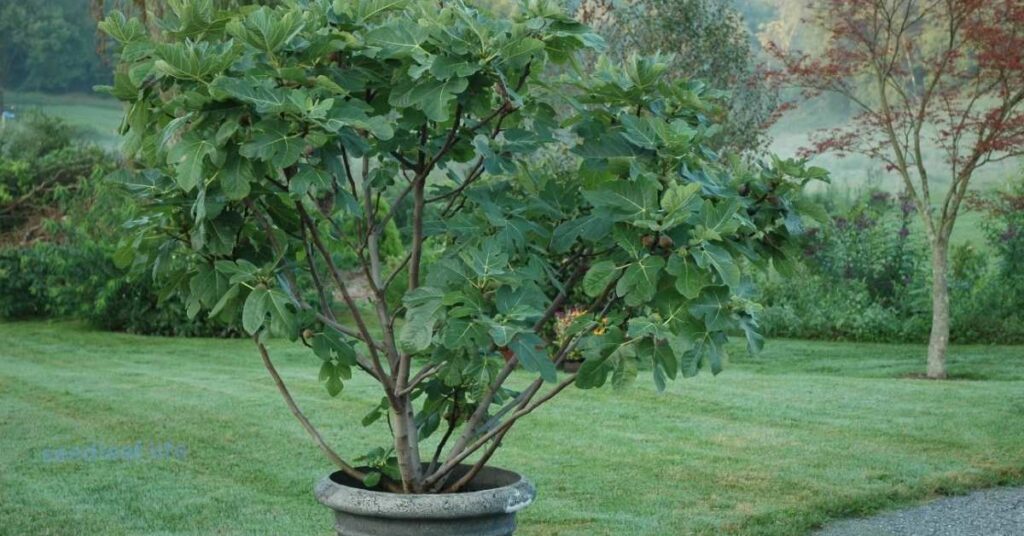
Enjoy homegrown figs by learning how to plant a fig tree in your garden. Just like fig trees, you can also grow nutritious goji berries at home to enjoy fresh, healthy fruit
Fresh, Organic Figs Anytime
- Imagine plucking ripe figs from your own garden—a sweet reward that captures the essence of summer and shows why learning how to plant a fig tree is so rewarding.
- Growing a fig tree at home not only offers fresh, organic figs whenever you desire, but it also transforms your space into a personal oasis of joy and flavor.
Low Maintenance and Drought-Tolerant
- Fig trees are perfect for busy lifestyles. They don’t require constant attention, making them ideal for beginner gardeners.
- Even with minimal care, they thrive beautifully and continue to produce delicious fruit.
Great for Small Spaces or Patios (Container-Friendly)
- You don’t need a large backyard to grow figs. These trees do wonderfully in containers, making them suitable for balconies, terraces, or patios—anywhere you want to add a touch of greenery.
Beautiful Shade Plant
- With their broad, lush leaves, fig trees also serve as natural shade providers. They create a cozy, relaxing nook in your outdoor area where you can unwind and enjoy nature’s comfort.
Emotional & Lifestyle Benefits
- Incorporating a fig tree into your home life offers more than just fruit — it nurtures a deeper connection with nature.
- Picture yourself sipping your morning coffee under its shade, surrounded by calm and greenery.
- The simple act of planting a fig tree brings peace, joy, and a sense of accomplishment to your daily routine.
Choosing the Right Fig Variety
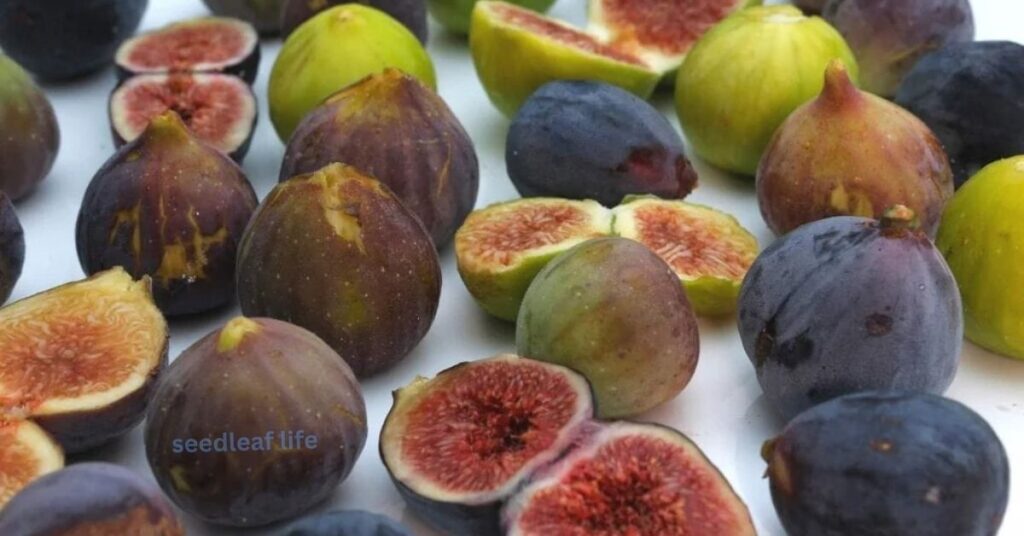
When choosing the right fig variety for your home garden, especially if you’re planning how to plant a fig tree successfully, consider the Brown Turkey, Black Mission, Kadota, and Celeste figs. Each type has its own charm and growing preference, making it easy to find one that fits your space and climate perfectly.
Best Varieties for Home Gardens (e.g., Brown Turkey, Black Mission, Kadota, Celeste)
- Brown Turkey Fig: A forgiving and versatile variety that thrives in various conditions. It produces delicious fruits late in the season, making it perfect for home gardeners learning how to plant a fig tree for the first time.
- Black Mission Fig: Known for its rich flavor and deep color, this variety flourishes in warmer climates and adds an elegant touch to your garden.
- Kadota Fig: If you prefer sweeter figs, Kadota is a great choice. It’s perfect for fresh eating or making preserves.
- Celeste Fig: Prized for its sweetness and adaptability, Celeste is ideal for both beginners and experienced gardeners.
Climate Considerations (Warm vs. Cold Regions)
Climate plays a key role when deciding how to plant a fig tree and which variety to choose.
- Warm regions favor varieties like Black Mission, which loves abundant sunlight and heat.
- Cooler areas are better suited for Brown Turkey or Celeste, as these types can tolerate mild chills and adapt to varying conditions.
Indoor vs. Outdoor Fig Tree Growing: Learn How to Plant A Fig Tree
When planning how to plant a fig tree at home, consider your available space. Fig trees thrive outdoors but can also be grown indoors in containers if space is limited.
- Outdoor planting is ideal for faster growth and fruit production.
- Indoor or patio containers work well when there’s plenty of sunlight and warmth.
With the right variety and growing conditions, you’ll soon enjoy your own supply of fresh, homegrown figs — learning firsthand how to plant a fig tree that flourishes season after season.
Where Fig Trees Grow Best Around the World
Figs (Ficus carica) are loved across the globe for their sweet flavor and easy growth.
They thrive in warm, Mediterranean-style climates — sunny days, mild winters, and well-drained soil.
Here’s a look at where fig trees grow best and the ideal planting seasons for each region:
| Region / Country | Best Growing Areas | Ideal Planting Season | Notes |
| Mediterranean (Italy, Greece, Spain) | Coastal and inland warm zones | Late winter to early spring (Feb–Mar) | Traditional fig-growing regions; famous for Black Mission & Kadota figs |
| United States (California, Texas, Florida) | USDA Zones 8–10 | Late winter or early spring (Feb–Apr) | California is one of the world’s largest fig producers |
| Turkey | Aydın, İzmir, Bursa | Late winter (Jan–Feb) | Turkey is the top global exporter of dried figs |
| Iran | Fars, Kerman provinces | Early spring (Mar–Apr) | Ideal dry, sunny climate for sweet figs |
| Egypt | Nile Delta, North Coast | Late winter to early spring (Feb–Mar) | Thrives in sandy, well-drained soil |
| India | Maharashtra, Gujarat, Tamil Nadu | Spring (Feb–Apr) or Monsoon (Jul–Sep) | Locally called Anjeer; Pune region famous for cultivation |
| Pakistan | Balochistan, Sindh, Punjab plains | Late winter (Jan–Feb) or Late Monsoon (Aug–Sep) | Figs grow well in warm, frost-free areas |
| Australia | New South Wales, South Australia | Late winter to early spring (Aug–Oct) | Prefers warm coastal or inland valleys |
| Mexico | Baja California, Sonora | Early spring (Feb–Apr) | Strong sunlight boosts fruit sweetness |
| South Africa | Western Cape | Late winter (Aug–Sep) | Mediterranean-like climate perfect for fig orchards |
Wherever you are in the world, figs thrive in warmth and care — once you know your region’s right season, planting becomes easy and rewarding.
9 Easy Steps to Plant a Fig Tree and Grow Delicious Figs
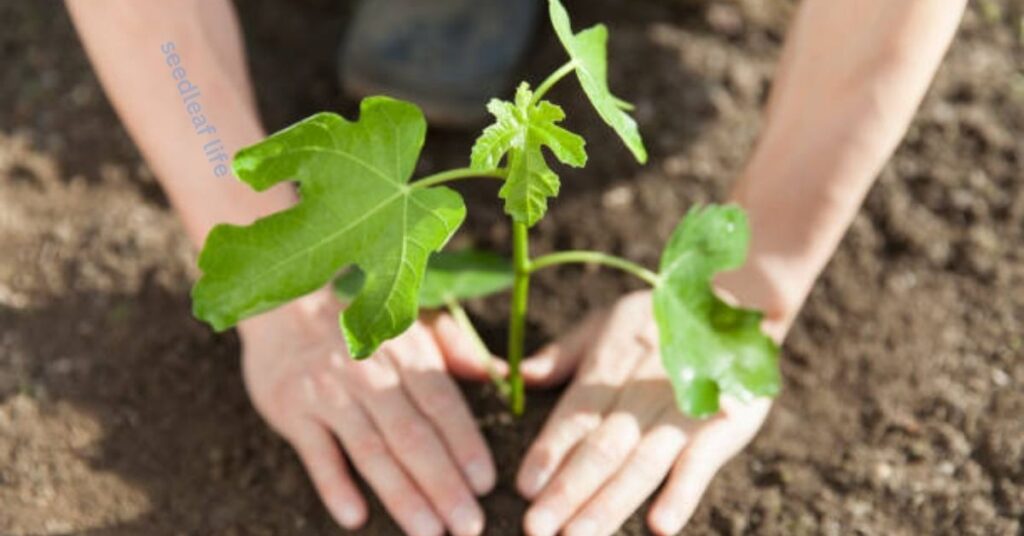
Learning how to plant a fig tree is easier than you might think! With just a little care and planning, you can enjoy fresh, homegrown figs right from your garden or patio. Follow these nine simple steps to give your fig tree the best possible start.
Step 1: Choose the Perfect Location (Full Sun, 6–8 Hours Daily)
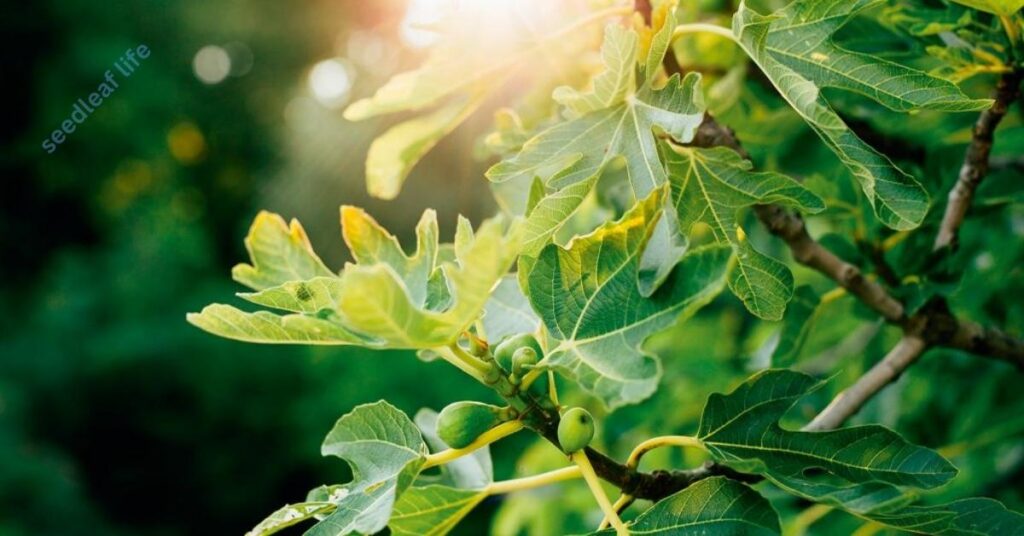
Select a sunny spot where your fig tree can soak up at least 6–8 hours of direct sunlight each day. Fig trees love warmth — a south-facing area is ideal for healthy growth and sweet fruits.
Step 2: Test and Prepare the Soil (Well-Draining, Slightly Acidic pH 6.0–6.5)
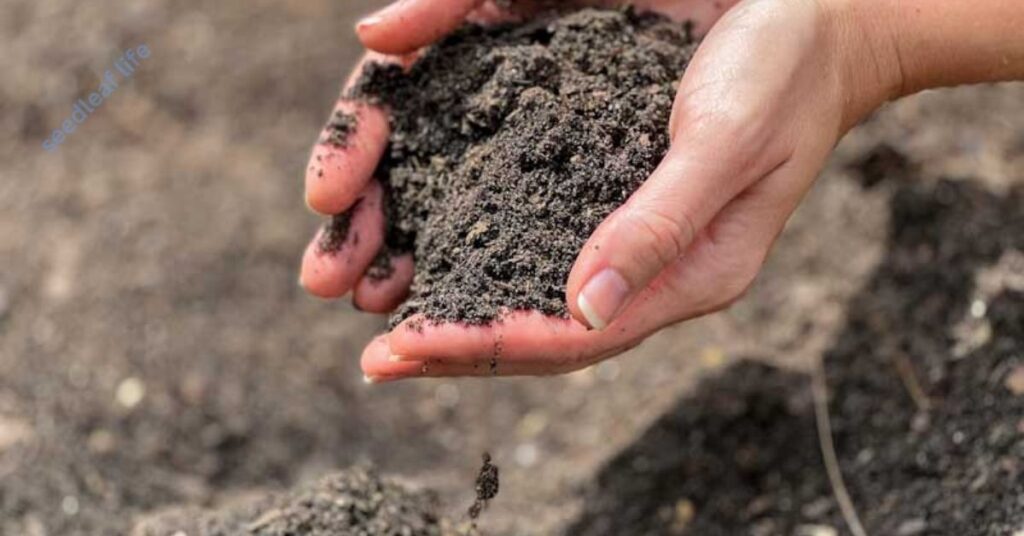
Before planting, test your soil’s pH. Figs thrive in slightly acidic, well-draining soil (pH 6.0–6.5). If needed, amend the soil with organic compost or peat moss to improve texture and fertility.
Step 3: Dig the Hole (Twice the Width of the Root Ball, Same Depth)
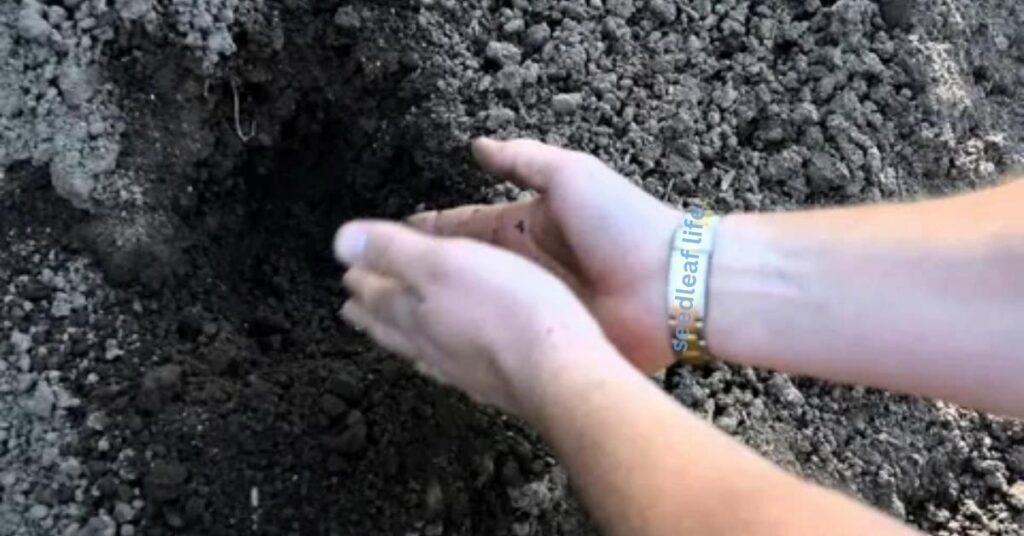
Dig a hole that’s twice as wide as the root ball but not deeper than its height. This gives roots plenty of space to spread and anchor firmly.
Step 4: Add Compost or Organic Matter
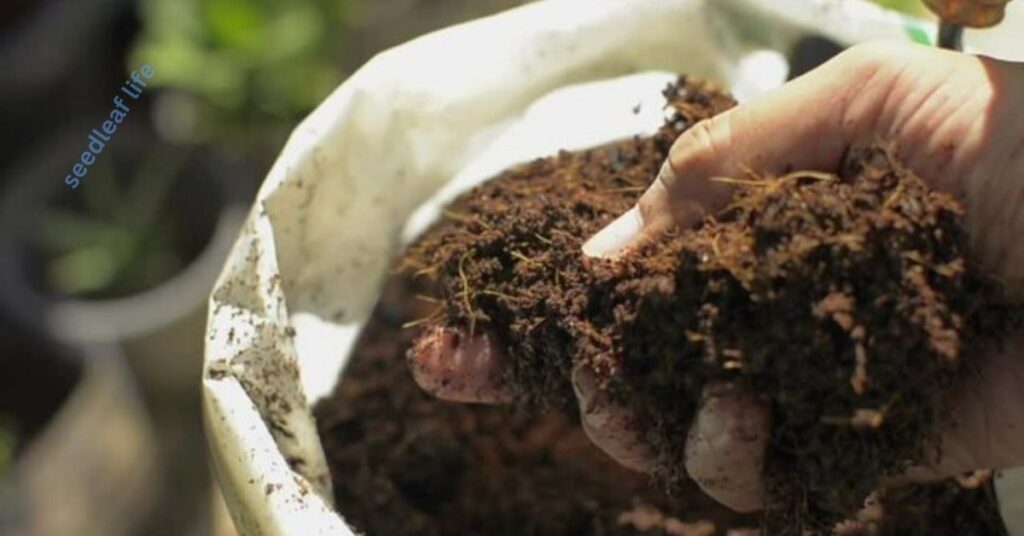
Mix in compost or well-rotted manure at the bottom of the hole to enrich the soil and promote strong, early root development.
Step 5: Place the Fig Tree Carefully in the Hole
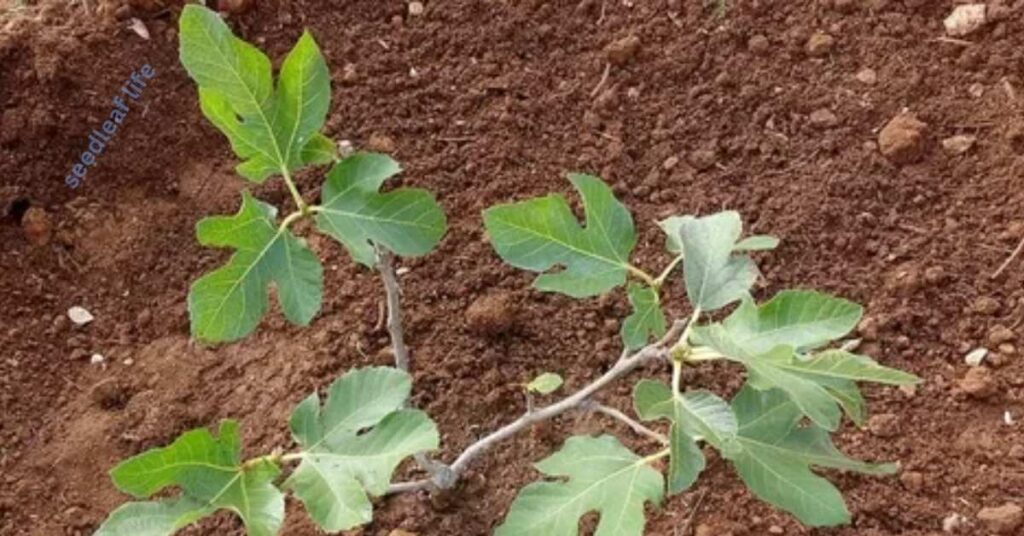
Position your fig tree upright in the center of the hole. Make sure it’s standing straight and at the same depth as it was in its original container.
Step 6: Fill and Gently Tamp the Soil
Backfill the hole with the prepared soil mixture. Gently tamp down the soil to remove air pockets, ensuring the roots have good contact with the ground.
Step 7: Water Deeply and Mulch Around the Base
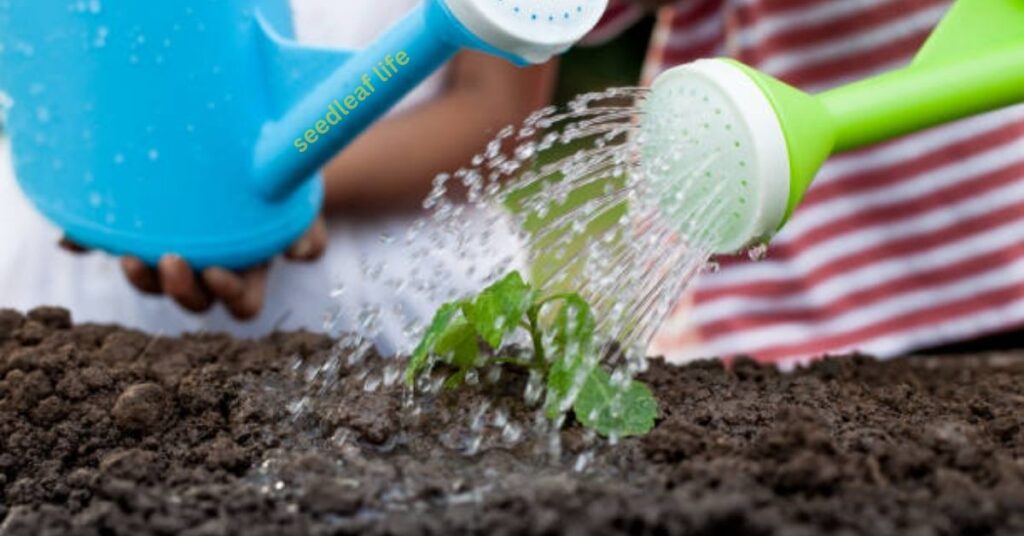
After planting, water deeply to settle the soil and hydrate the roots. Then, apply a 2–3 inch layer of organic mulch around the base to retain moisture and suppress weeds.
Step 8: Stake the Tree if Needed for Support
If your fig tree is young or planted in a windy area, use a garden stake for extra support until it becomes well-established.
Step 9: Maintain Regular Watering During the First Growing Season
Consistency is key! Keep the soil evenly moist but not soggy during the first growing season. This helps your fig tree establish a strong root system for future growth.
Use organic mulch (like straw or wood chips) to lock in soil moisture, regulate temperature, and discourage weeds — a simple yet powerful step in mastering how to plant a fig tree successfully.
How to Grow a Fig Tree from a Cutting or Branch
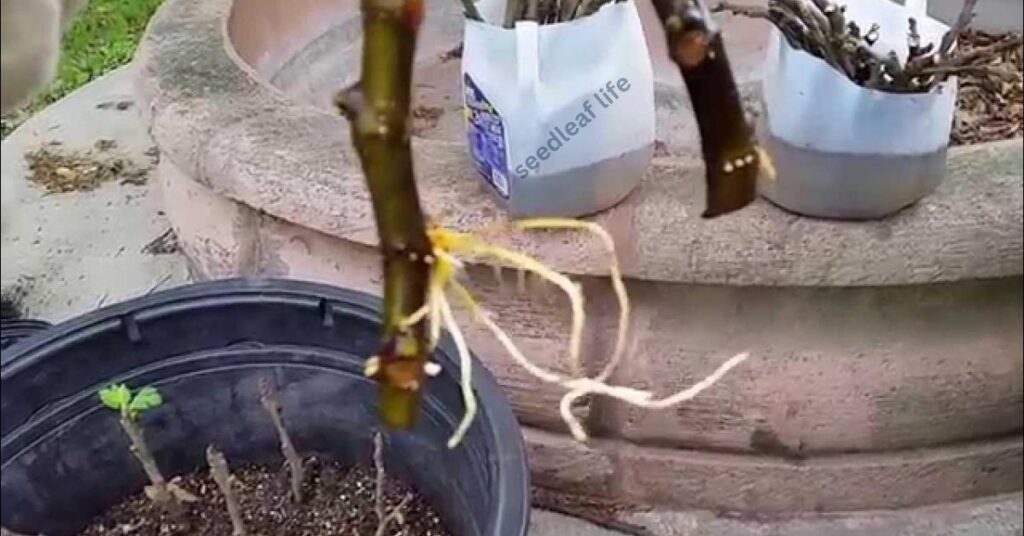
Taking cuttings from a fig tree is an exciting and rewarding journey — it’s one of the simplest ways to grow your own fruit at home.
Whether you’re propagating a favorite variety or starting a new plant from an existing tree, learning how to plant a fig tree from a cutting is easy and highly successful when done right.
When and How to Take Cuttings
The best time to take fig cuttings is in late winter or early spring, while the tree is still dormant. This is when the branches are full of stored energy, ready to develop new roots.
Look for healthy, pencil-thick branches about 6 to 8 inches long with at least three nodes. Using sharp, clean pruning shears, make a clean cut just below a node — this helps roots form more easily later on.
Tip: Always use sterilized tools to prevent infection or rot in the cutting.
Rooting Method (In Soil or Water)
Once you’ve taken your cuttings, you can choose between soil rooting or water rooting — both work beautifully.
- Rooting in Soil:
Fill a small pot with well-draining potting mix, ideally with some perlite or sand. Plant the cutting about two inches deep, ensuring one or two nodes are below the soil. Keep the soil lightly moist but never soggy, and place the pot in a warm, bright location. - Rooting in Water:
Place the cutting in a glass of clean water, making sure at least one or two nodes are submerged. Change the water every few days to keep it fresh and oxygenated. Within a few weeks, you’ll start to see tiny white roots forming.
Patience is key here — rooting can take anywhere from 2 to 6 weeks, depending on temperature and humidity.
Transplanting Rooted Cuttings to Pots or Garden
Once your fig cutting develops strong, visible roots, it’s time to transplant it into soil.
- If you rooted your cutting in water, gently move it to a pot filled with rich, well-draining soil.
- If your cutting was already in soil, carefully lift it, being gentle with the new roots.
Make a small hole in a larger pot or directly in your garden and place the rooted cutting inside. Cover it with soil, press gently, and water lightly.
Keep your young fig plant in a sunny, warm spot, and within a few weeks, you’ll notice new leaves emerging — a clear sign your cutting has adapted well.
Soon, you’ll have a thriving fig tree that you grew with your own hands — a living symbol of patience and care, rewarding you with delicious fruit for years to come.
Soil Preparation for Fig Trees
To grow healthy and productive fig trees, the secret starts below the surface — with the right soil preparation. Fig trees thrive in loamy, well-drained soil that balances moisture while allowing excess water to escape. When you understand how to plant a fig tree in the right soil, you’re already halfway to success!
Ideal Soil Type: Loamy and Well-Drained
Fig trees prefer loamy soil, rich in organic matter yet light enough for water to flow through easily. This balance prevents root rot while keeping the roots hydrated.
- Best mix: Loam and compost , perlite or sand
- pH range: Slightly acidic to neutral (6.0–6.5)
- Bonus tip: If your garden soil is heavy clay, use raised beds or large containers for better drainage.
Add Compost, Perlite, or Sand for Aeration
A healthy fig tree starts with airy soil that lets roots breathe.
- Compost adds nutrients and organic richness.
- Perlite improves aeration and keeps the soil light.
- Sand enhances drainage, especially in compacted soils.
Mixing these ingredients creates the perfect environment for root expansion and fruit development — a must if you want to master how to plant a fig tree successfully.
How to Check Soil Drainage
- Testing your soil drainage is quick and easy:
- Dig a 12-inch-deep hole in the planting area.
- Fill it with water and let it drain completely.
- Refill the hole with water again.
- If the second fill drains within 1 hour, your soil is ideal.
- If it drains too slowly, blend in extra perlite or coarse sand to improve drainage and oxygen flow.
Natural Fertilizer Mix Recipe
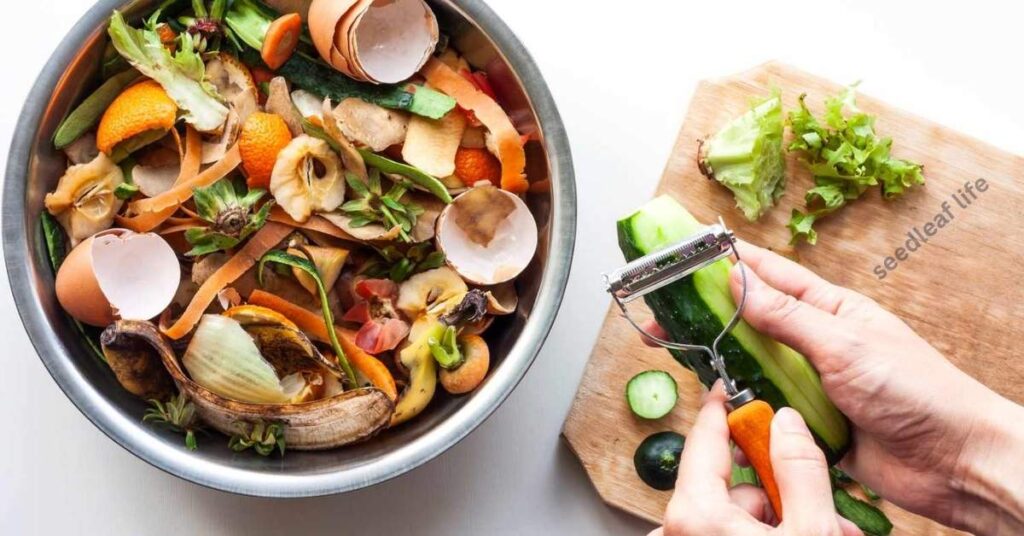
For those who love organic gardening, here’s a simple homemade fertilizer blend to feed your fig trees naturally:
- 1 part aged manure (for nitrogen and minerals)
- 1 part bone meal (for phosphorus and root growth)
- 1 part seaweed extract or kelp meal (for micronutrients and overall vigor)
Mix well and apply lightly around the base of your fig tree every few months. This gentle blend supports strong, balanced growth and encourages a bountiful harvest of sweet figs.
When you know how to plant a fig tree with the right soil preparation, you’re setting the stage for years of healthy growth, vibrant leaves, and delicious fruit. Happy planting!
Container Growing: How to Plant a Fig Tree in a Pot
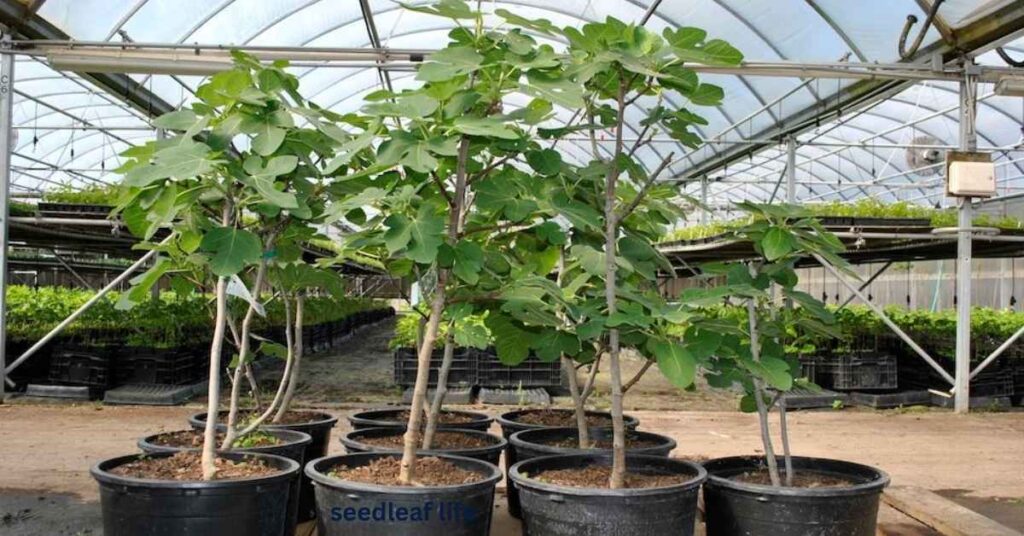
Planting a fig tree in a pot is a rewarding experience for any garden enthusiast. Learn how to plant a fig tree in a container with the right soil, sunlight, and care, and enjoy fresh figs at home.
Best Container Size and Type (Minimum 18–24 Inches Wide)
Choosing the right pot is the first step toward success.
- Select a container that’s at least 18–24 inches wide and deep, giving your fig tree plenty of room to grow.
- Clay, ceramic, or terracotta pots are great choices — they promote good air circulation and prevent root rot.
- Make sure your pot has adequate drainage holes at the bottom to let out excess water.
Tip: If you live in a colder region, choose a lightweight plastic container so you can easily move it indoors during winter.
Potting Mix Composition
A healthy fig tree starts with a balanced soil mix. Combine:
- High-quality potting soil (for nutrients and structure)
- Perlite (to improve drainage and aeration)
- Compost (to boost organic matter and long-term fertility)
Aim for slightly acidic to neutral soil (pH 6.0–7.0). This combination keeps the roots healthy and encourages steady growth throughout the season.
Watering and Sunlight Tips for Indoor or Balcony Planting
Figs love moisture and sunshine — the key ingredients to success!
- Keep the soil consistently moist, but avoid overwatering. Let the top inch of soil dry slightly between waterings.
- Place your fig tree in a bright, sunny spot — near a south-facing window or out on a balcony with 6–8 hours of sunlight daily.
- Watch for drooping leaves — it’s a clear sign your plant needs water.
Regular attention to light and moisture ensures your fig tree stays lush, happy, and productive all year long.
If you provide these simple conditions, you’ll soon enjoy delicious homegrown figs from your very own potted tree — proof that even limited spaces can yield sweet rewards.
How to Plant a Fig Tree and Keep It Thriving
Once you’ve mastered how to plant a fig tree, the next step is learning how to care for it throughout the year for healthy growth and fruiting. A good care routine — from watering and feeding to pruning and protecting — will ensure your tree stays healthy and produces sweet, juicy figs for years to come.
Watering Schedule (Especially During Summer)
Watering is one of the most important aspects of fig tree care.
- During hot summer months, water your fig tree deeply once a week, ensuring the soil is fully soaked but not waterlogged.
- In heatwaves, check the soil more often — if it feels dry two inches below the surface, it’s time to water.
- The goal is to keep roots evenly moist, as dry soil can cause stress and reduce fruit yield.
Tip: Mulching around the base helps lock in moisture and keeps the roots cool during scorching weather.
Fertilizing Frequency
To encourage strong growth and a bountiful harvest:
- Feed your fig tree with a balanced fertilizer every 6–8 weeks during the active growing season (spring through summer).
- Organic options like compost, worm castings, or well-rotted manure are great choices — they nourish the soil naturally and improve its texture over time.
Avoid over-fertilizing; too much nitrogen can produce lush leaves but fewer fruits.
Pruning for Shape and Fruiting
Pruning keeps your fig tree neat, healthy, and productive.
- In early spring, before new growth starts, trim away any dead, weak, or overcrowded branches.
- This allows sunlight and air to reach the inner canopy, promoting better fruiting and reducing the risk of pests or disease.
- Light pruning throughout the season can also help maintain your preferred tree shape.
Winter Protection Tips (For Colder Areas)
If you live in a region with chilly winters, your fig tree needs some extra love.
- Spread a layer of mulch (straw, dry leaves, or wood chips) around the base to insulate the roots.
- During frost or freezing nights, wrap the branches with burlap or move potted figs indoors near a sunny window.
- Avoid overwatering during dormancy — keep the soil slightly moist but never soggy.
With these steps, your fig tree will rest safely through winter and burst back to life come spring.
When Will Your Fig Tree Produce Fruit?
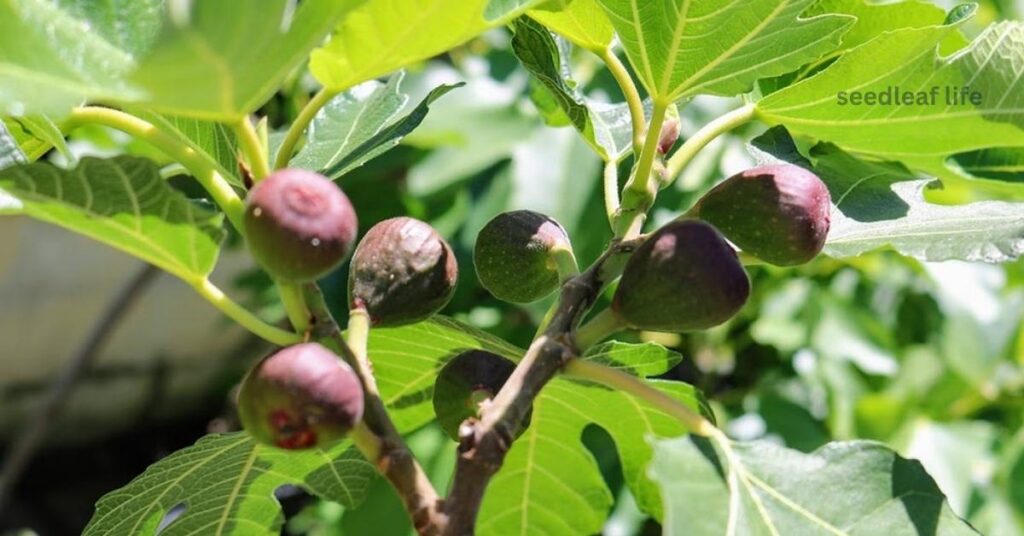
Growing a fig tree is a lesson in patience and reward — it won’t take too long before you see the results of your care and attention.
Expected Fruiting Timeline (1–2 Years from Planting)
A fig tree typically starts to produce fruit within 1 to 2 years after planting. During this time, your tree focuses on establishing strong roots and healthy growth. If you’ve learned how to plant a fig tree correctly — with good soil, sunlight, and watering — you’ll be rewarded sooner with those sweet, homegrown figs.
Signs of Healthy Fig Tree Growth: How to Plant a Fig Tree Right
Watch for lush, bright green leaves and steady new growth. These are indicators that your fig tree is settling well and preparing to bear fruit. A thriving tree often shows small fig buds forming on new branches as it matures — a sign that your efforts are paying off!
Common Issues That Delay Fruiting
If your fig tree isn’t producing fruit yet, don’t worry. A few common problems can cause delays, such as:
- Poor soil quality or lack of nutrients
- Insufficient sunlight (needs at least 6–8 hours daily)
- Overwatering or poorly drained soil
- Stress from repotting or temperature changes
Ensuring your tree is planted in well-draining, nutrient-rich soil and gets plenty of sun can make all the difference. With patience, proper care, and a solid understanding of how to plant a fig tree, you’ll soon enjoy the sweet taste of your very own harvest.
Common Problems and Solutions
Even healthy fig trees can face small challenges, but if you know how to plant a fig tree and care for it properly, they bounce back quickly. Here’s a simple table to help you diagnose and fix common issues.
| Problem | Possible Cause | Quick Fix / Organic Solution | Prevention Tips |
| Yellowing Leaves | Overwatering or nutrient deficiency | Let soil dry if soggy; mix balanced organic fertilizer into soil | Water only when top inch of soil feels dry; maintain good drainage |
| Pests (Aphids, Spider Mites) | Dry air or weak plant immunity | Spray a mix of mild soap and water, or use neem oil | Inspect leaves weekly; keep foliage clean and well-hydrated |
| Fruit Drop | Sudden temperature changes or irregular watering | Keep consistent watering and mulch around base to retain moisture | Protect tree from strong winds or heat; avoid letting soil dry out completely |
| Slow Growth | Poor sunlight or compacted soil | Move to a sunnier spot; loosen soil and add compost | Ensure 6–8 hours of direct sunlight daily |
| Wilting Leaves | Root stress or overwatering | Check drainage holes; re-pot if roots are waterlogged | Use well-draining soil with perlite or sand |
Knowing how to plant a fig tree correctly from the start prevents most of these problems. With healthy soil, enough sunlight, and regular organic care, your fig tree will thrive and reward you with sweet, homegrown fruit.
Conclusion
Learning how to plant a fig tree is a simple and fulfilling way to bring nature into your home. By following the easy steps — from choosing the right location to providing care and sunlight — you’ll soon enjoy the reward of fresh, organic figs right from your garden.
With patience and consistent care, your fig tree will thrive for years to come, adding beauty and joy to your space.
Ready to enjoy homegrown figs? Start with one cutting today and watch it thrive!

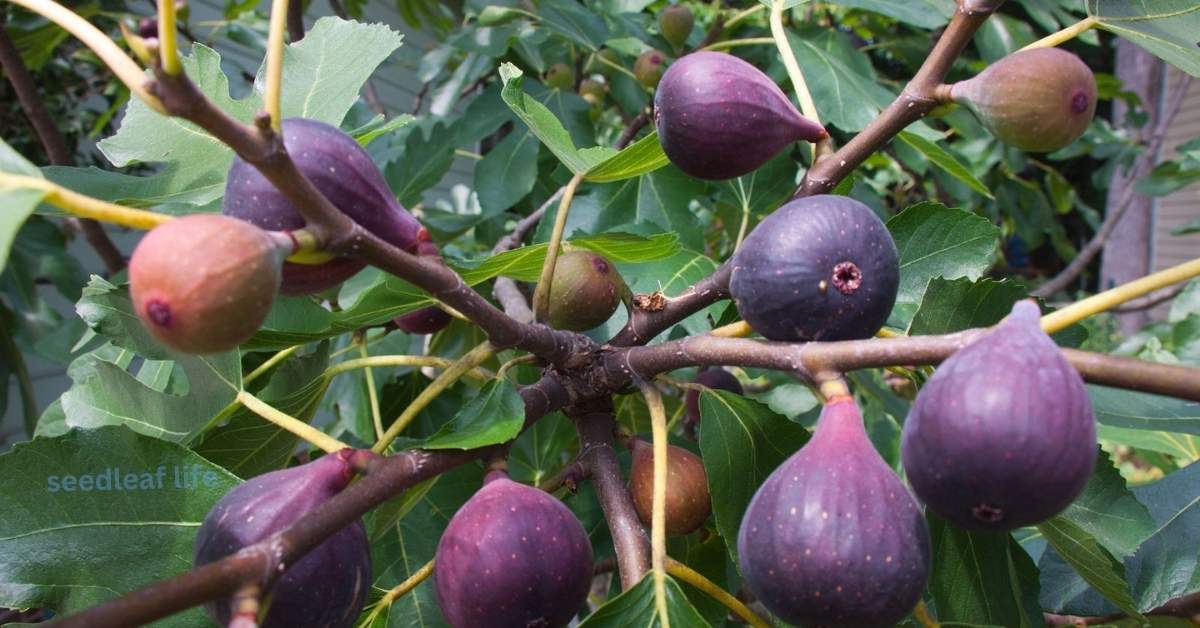
Leave a Reply
You must be logged in to post a comment.